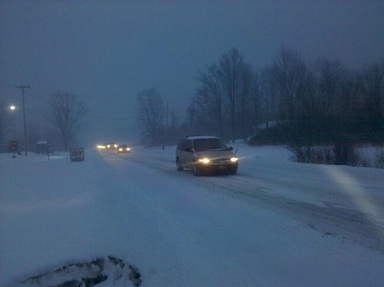February 1, 2011
Return to Nineteenth-Century Patterns
Again, a very different fictional scenario to consider in the light of planning land use for the next few decades.
(fiction)
The economy was just about to turn the corner, and then... oil prices climbed to new records, bringing $10 a gallon gasoline. The economy was just about to turn the corner, and then... electricity prices climbed to new records, as customers raced to buy electric cars. The economy was just about to turn the corner, and then... natural gas prices surged, as shale gas wells turned out not to last as long as forecast, and demand for natural gas had climbed to feed new oil plants.
By 2022 gasoline and equivalents were floating between $21 and $26 a gallon. Even with smaller and more efficient cars, houses that had made wonderful sense when gasoline was $1.50 and even good sense when gasoline was $4.50 now seemed impossible, except as farmhouses or off-grid retreats. The colleges in the area continued to operate, but as pedestrian zones served exclusively by buses. Downtown Ithaca doubled in population, but the permanent population of Tompkins County shrank overall as residents moved to more energy-efficient urban settings.
The impact on Dryden was grinding and relentless, with residents unable to sell houses for nearly the prices they had paid for them. The costs of paving and plowing drove the Town to return many roads to dirt, and to consolidate greatly reduced plowing operations on the remainder with the county. Horses, sleighs, and skis kept large areas of the town moving in winter. Coordination with TCAT kept buses coming to smaller neighborhoods in Dryden, including Yellow Barn and West Dryden, as well as along the main state highways, but the population of the town had fallen to 10,000 in 2020 (from 14,000 in 2010) and would fall further to 5,000, roughly its population in 1950.
While demolition was a more common project than construction, and consolidation of parcels more popular than subdivision, a few areas held on. The villages of Dryden and Freeville resumed their historic roles as distribution centers for their surrounding countryside. The hamlets, especially Varna, managed to hold their own. They didn't grow, but they didn't shrink very much either. Stores, though small stores, returned to Varna, as the five-minute drive to East Hill Plaza grew to cost $8 by car or $2 by bus.
Other neighborhoods faced more difficult challenges. The 2012 zoning for Ellis Hollow, Bethel Grove, and Etna allowed no retail, and it wasn't until 2018 that these areas were able to get a year-round local grocery store. The 13/366 overlap subsisted on the remaining traffic flows, but efforts to create highly efficient super-dense housing in the former NYSEG building stalled for years as zoning that prohibited any residential use and then financing questions buffeted the project. It finally opened in 2025, highly efficient but with a much higher vacancy rate than planned.
In 2023, the Town abandoned zoning, concluding that the vision supported by the decade-old plan was unsupportable in the current crisis. The high cost of energy would govern development, much as it had in the 19th century.
Other zoning fiction here:
- One plausible scenario for excessive development along 13
- Zoning disputes echoing in the quiet...
- Overwhelming demand
- Return to Nineteenth-Century Patterns
If you have stories you'd like to tell (or see me tell), let me know, in email or in comments.
Pretty, except for the commute
Today's snow seems aimed right at early morning commuting, and roads are the whitest I've seen on a workday in a while.
Not so clearly a kidnapping
The Dryden resident accused of kidnapping a Ithaca man was released:
Judge Christopher Clauson released Jason H. Smith, 25, after his preliminary felony hearing in Dryden Town Court Thursday, said Smith's attorney William P. Sellers IV. Clauson found that Assistant District Attorney Linda Gafford didn't present sufficient evidence to hold him pending grand jury action, Sellers explained.
It seems to be a marijuana deal gone very strangely wrong.
February 3, 2011
Dryden Solutions focuses on widening the energy conversation
If you have ideas for getting Dryden residents interested in energy efficiency, please join the conversation!
February Dryden Solutions - Tuesday February 8th 6:30pm at the Café
Continuing our push for more energy efficiency, we will focus on more creative ways to increase interest in using less energy in our Town.
- What print opportunities exist that could remind people of the benefits?
- Could energy efficiency messages go out in advertising circulars, newsletters, bulletins, or listserves that businesses or organizations already produce?
- How could the arts help?
- How can we make the message more public - more visible - to create interest?
- How could we use radio?
What initiatives could make it seem perfectly normal to get an energy audit and retrofit one's home? "Everybody's doing it!"
We will brainstorm, gather the best ideas, and make plans to mobilize local resources to help create the "buzz" we need to make big gains in Dryden on energy efficiency.
February 5, 2011
Farewell, beautiful Spring

Spring enjoys my parents' porch, shortly after we got her.
When Tracey and I first met Spring, at Blue Jay Kennels outside of Corning, she was happy to see us. She'd apparently been picked up on East 2nd Street, and was a thin but pretty little dog who we later found had survived a bout with parvovirus. She immediately showed personality, grabbing a biscuit there, jumping on a table to eat pizza at our apartment, and running down the shoulder of Route 54 as we frantically chased her near Keuka Lake.

Spring keeping an eye on the neighborhood.
She fit happily into the new house, where she had windows for watching the road and a dog door to go out any time she liked. For a long time, we joked that we had adopted a cat, as she was pretty shy. She was never fond of other dogs, though she got along well with our other dog, Sprocket, who's since moved to Rochester with Tracey. She mostly got along with Angelika's more recent cats, though usually not on the first floor of the house, which Spring considered quite definitely hers, especially near the food dish.

Spring rests at the top of the stairs.
She marveled at our weather, welcomed Sungiva and Konrad home, and enjoyed a quiet retirement, staying beautiful if grayer, barking at pedestrians and finally exploring more of our yard last summer.

Spring enjoys some snow, just before the new year.
Spring left us this morning, after a hard week of renal failure and not wanting to eat any longer. I'm sure she's running somewhere now, through the grass, snow, and forests she loved to fly through, always in search of something fun to sniff and see. Running away, as usual, but always beautiful.
I've posted a short gallery of pictures if you'd like to see more of this wonderful dog. I'll always miss her.
February 8, 2011
Can you drive a veteran?
This morning's Ithaca Journal notes that the new VA facility on Route 13 is looking for volunteer drivers to bring patients there.
TC3 is preparing for even more bad news from the New York State budget:
The Tompkins Cortland Community College president saw the college endure a $2.5 million cut in state aid from the fall of 2009 to the fall of 2011. So when Gov. Andrew Cuomo presented his proposed budget Tuesday, Haynes said he expected bad news.
"When we finished cuts in December -- 30 positions were cut in total -- that was in preparation for the worst-case scenario and the governor's proposal is awfully close to that," he said.
Under Cuomo's proposed budget, TC3's base state aid would be cut by 10 percent, Haynes said. This year, the college receives $2,260 per full time-equivalent student. Under the proposal, TC3 would receive $2,034 per FTE. That is about a $1 million cut in state aid, he said....
Over the past 15 months, he said, the college's state aid has been reduced by 24 percent.
Ouch. That's an amazing drop, and keeping the doors open can't be getting any easier.
February 9, 2011
Town Board discussing more zoning tonight
I'm way late in posting this, but if you have a chance, tonight's the Dryden Town Board's monthly agenda and zoning meeting. It starts at 7:30pm at the Dryden Town Hall, 93 East Main Street (Route 392), Dryden.
The agenda doesn't say much about what they'll be talking about with zoning in particular, but it may give you a sense of how early you want to get there. Usually they get to zoning 45 minutes to an hour into the meeting.
February 11, 2011
Chocolate! Chocolate!
The tastiest Dryden festival of the year comes tomorrow, at Houtz Hall in Etna, from 10:00am to noon. The Etna Chocolate Festival is delicious, with a wide variety of chocolate-based treats for you to enjoy. Tastes of everything cost a quarter, and filling a tray with tastes makes for a really spectacular brunch. You can also buy larger pieces to take home, and coffee, milk, and hot chocolate are complementary.
You can see what it looked like a few years ago. Delicious!
(If you're more in the mood for pancakes and breakfast food, you can find that Sunday morning at the Varna Community Center.)
A Dryden blog as busy as this one
Or busier, lately, though definitely seeing the world from a different perspective.
One of Nine is pretty clearly not "one Democrat's perspective on life in the Town of Dryden". Their "about" is pretty general (and reminds me that I don't really have one here):
Dryden is one of nine towns in Tompkins County.
Our focus is local, our town... other towns... the county, including the City of Ithaca. Our state assembly and senatorial districts. Our congressional district. Our state. And our nation.
Our focus is on our sphere of influence, those things we can affect and which, with prayer, care, and a little luck, may shed some light for others.
Reading through it, it's not quite as obsessively Dryden-centric as this site, but it's pretty close. If you're looking for a (far) more conservative take on local issues, definitely check it out!
Events, sustainability, and health
I can't say that I love the Ithaca Journal web site redesign, which seems mostly to make me scroll more and wonder where if anywhere the commented stories are. Performance hasn't improved, either - it's the only site I visit regularly where I wonder when the page will finish loading. Maybe someday...
Cathy Wakeman's Dryden Town Talk fortunately puts Dryden news in an easy place to find. After talking about how Village of Dryden mayor Randy Sterling came to talk with Cub Scouts, she notes that the Village of Dryden's Mayor and Trustees are having open meetings with the public on February 23rd and March 8th, both at 7:00pm at the Village Hall, 2nd Floor. I was very glad to see them doing that, as the elections are uncontested this year. A forum is at least a conversation!
She also notes a new pastor at Reach Out for Christ Church, a "Lincoln Dinner" being held tonight to start celebrations of the 180th year of the Dryden United Methodist Church, the Etna Chocolate Festival tomorrow, the Varna pancake breakfast at the Varna Community Center Sunday, a seed sale at the Ellis Hollow Community Center, and a full calendar of events at the Southworth Library.
Sustainability Planner Katie Stoner, who is working for both the Town of Ithaca and the Town of Dryden, writes about green initiatives at the municipal level. Her list for Dryden includes about the last five years of work, I think:
Town of Dryden
- Energy efficiency upgrades at highway department completed.
- Geothermal system and high-efficiency lighting added to town hall facility.
- Provided funding for local residents to get energy audits.
- Sustainability planner hired. [that would be Katie Stoner]
- Energy coordinator to be hired in 2011.
- Sustainability planning process under way.
Next Tuesday the 15th, you can check out an indoor seed preparation class held from 6:30 to 8:00pm at the Dryden Community Center Cafe.
The Dryden Community Trail (the Jim Schug Trail?) gets mentioned in an article about a $1.2 million grant to go toward healthy living and exercise projects.
The uneven effect of cuts and caps
I still need to sit down and look at what Governor Cuomo has proposed in his budget - though it will help when all the pieces are there. In general, I think New York State has substantial duplication and waste in its government, and mandating counties to provide services that turn them mostly into local offices of state government doesn't help. Unfortunately, though, neither the completely broken collection of people we call a legislature nor decades of past governors have shown much sign of figuring out how to improve efficiency without just slashing at services and often making things even more expensive.
I'm glad that the Governor is talking about shared sacrifice, but then I look at some of the details and wonder just how many nightmares lurk under the surface of his rhetoric. Albany seems to look everywhere except in Albany for substantial cost reductions.
Dryden Daily KAZ has done a much better job than I have at keeping up with the story, noting the governor's call for suggestions to reduce mandates, and writing a (so far) four-part series on the budget (1 2 3 4).
The last piece makes an especially important point:
Because Angie's school depends less on state aid, cuts in the governor's 2011-12 budget affect her far less than they do Ben, even though the percent cut to her district is greater. Angie's district will lose 10.89 percent of its aid, for a total of $205,940. Ben's district will lose 6.59 percent of its aid--for a total of $1,113,612.
The governor's proposed tax cap will affect the two teens differently, as well. Ben's district may only raise its levy by $292,184 before hitting the cap. That equates to a maximum spending increase of about $162 per student. Angie's district may raise its levy by $495,363, for a maximum spending increase of around $274 per student (more than enough to make up the difference in lost state aid).
I already knew it was going to be an ugly year, but fear this conclusion is all too accurate:
New York State cannot afford to fund its schools. Ben's community cannot afford to make up the difference--even if there were no tax cap, and they were allowed to do so. In these worst of times, don't be fooled into believing that the budget cuts are "across the board." Under the current proposal, the rich stay rich, and upstate kids lose again.
Current state of zoning
The Town Board's agenda meeting didn't finish until 9:00pm Wednesday, so the zoning discussion was kind of late and rushed, ending around 10:15pm. Most of the substantial discussion was about mining - gravel and topsoil - and I think in the end the board decided to allow it with a special use permit in the Conservation zone. (It didn't look like there were resources in the Rural Residential zone to make it worth adding that possibility.)
There was some discussion of density formulas. Bruno Schickel continued his broad opposition to the size of the Conservation zone, but it didn't sound (though it was late) like he convinced the board any more than I've convinced them that the map and description of commercial zones is a horrible idea.
In running through the rest of the zoning, it sounded like the Planned Unit Development section was going to get a rewrite, mostly because the process it described isn't clear or workable. I suggested that in its present form it was a "get out jail free card" from zoning. Other changes sounded more like tweaks.
The Board did introduce a Sound Performance Standards Law, but that actually amends current zoning, and isn't (yet) part of the new zoning.
My best guess is that we'll see a new complete draft sometime this month, or maybe in early March, to appear on the Proposed Zoning Law page. Planning Director Dan Kwasnowski also said that there would be a tweaked map, though I don't know at all what to expect of that.
I know the Board wants to finish this, but I don't think they're done - in ways that go beyond Varna, where they've acknowledged not being done. I think they solved a lot of likely complaints about restrictions on uses by separating Neighborhood Residential from Rural Residential, probably the biggest step I've seen them take toward making this more digestible. I still think, though, that there's a lot of ugliness and missed opportunity lurking in that document. The use chart itself, the most visible piece, isn't all that different from current uses, but the definitions and much of the rest - yes, after all this time - still don't feel properly cooked to me.
For now, I'll hold off on more comments - except maybe for some fiction - until there's a clear new draft to work with.
February 12, 2011
Lifton town meetings
According to a mailing I got yesterday, Assemblywoman Barbara Lifton will be having town meetings across Tompkins and Cortland counties, though not one in Dryden.
They include:
2/22, Newfield Town Hall, 3:00pm to 5:00pm
2/22, Ithaca Town Hall, 7:00pm to 9:00pm
2/23, Cortlandville Town Hall, 7:00pm to 9:00pm
2/24, Lansing Town Hall, 3:00pm to 5:00pm
2/24, Groton Town Hall, 7:00pm to 9:00pm
Pick one that fits your schedule and geography, I guess! I likely won't.
February 14, 2011
More on education cuts
I wrote the other day about Dryden Daily KAZ's pieces on the governor's budget. She has an update - the last one, on education, appeared in today's Ithaca Journal, Elmira Star-Gazette, and Binghamton Press & Sun-Bulletin.
February 23, 2011
Events and attendance
In today's Dryden Town Talk, Cathy Wakeman talks about meeting with Dryden Seniors at their Valentine luncheon. She also notes the Dryden Mardi Gras, coming at 7:00pm on March 4th at the Dryden Methodist Church, a March 5th fair about Community Supported Agriculture, and an Ellis Hollow Nursery School open house also on Saturday.
Dryden County Legislator Mike Lane edged out fellow Dryden County Legislator Martha Robertson in attendance last year. Lane attended every single one of his legislature and committee meetings in 2010, while Robertson missed one meeting.
I think this was yesterday, but the SPCA held a spay and neuter day.
Political Patriot Plagiarism
I've been reasonably pleased (or at least much less annoyed than I expected to be) with our new Republican Congressman Richard Hanna. I was particularly happy he opposed extending provisions of the badly-misnamed PATRIOT Act recently.
Unfortunately, it seems that he needs to come up with his own reasons for opposing it. It seems to be mostly in passages describing the act:
"lone wolf" authority that allows non-citizens in our country who are suspected of involvement in terrorist activities to be monitored under the broad powers afforded by the Foreign Intelligence Surveillance Act (FISA), even if they are not connected to any overseas terror group or other "foreign power."...
blurs the... distinction between foreign intelligence... and domestic national security investigations....
allows intelligence wiretap orders to follow a target across multiple phone lines or online accounts....differ from the version available in ... cases, because the target of an order may be "described" rather than identified... similar to the "general warrants" the Founders were concerned to prohibit when they crafted the Fourth Amendment.
expanded the authority of the FISA Court to compel the production of business records or any other "tangible thing."
One bit I like from the Cato original is:
So let's stop living in a state of perpetual panic.
From the conclusion of Hanna's piece, it's pretty clear that he agrees.
It could be worse - at least it wasn't a Ph.D. thesis.
Update: I'm trying to decide if this is any better if it's self-plagiarized ghostwriting. Not sure.
February 24, 2011
Why do all these people drive past my house?
Well, hopefully in spring it'll be to enjoy the flowers I planted last fall, if they can actually see them while driving.
New York State counts 7383 vehicles going by my house daily, and at least some of those are among the 14,000 in-commuters coming to jobs in Tompkins County every day. Those commuters are a regular part of discussions about affordable housing, property taxes, and the "10 square miles surrounded by reality" cultural differences of the area.
Cornell knows more or less where its employees live, but I hadn't realized there was more information. While I knew that there were studies about them, I hadn't found anything detailed until recently, when I finally found Cornell's 2005 study of its commuting employees (PDF).
I'm more than a little annoyed with their survey design and what feels like incomplete result reporting, but this table shows responses from 1680 people who worked at Cornell and lived outside the county. They could pick any three, without any ranking given to responses.
| Reasons | Used to live in Tompkins County | Never lived in Tompkins County |
|---|---|---|
| Housing is less expensive. | 59.0% | 48.7% |
| Prefer the quality of life in their community. | 37.4% | 41.0% |
| Property taxes lower in their community. | 37.1% | 30.3% |
| Closer to family/friends. | 25.9% | 48.1% |
| Prefer schools in their community. | 19.9% | 21.9% |
| Spouse works outside the County. | 17.1% | 20.1% |
| Chose not to respond. | 2.0% | 1.9% |
498 (29%) of those respondents would move into Tompkins County if it was more affordable, which doesn't seem that strong a number overall. There's also a table about where those 498 would move, given the chance, but since it combined villages, cities, and hamlets into one large possible answer, it doesn't say much useful about where they'd like to live.
It's a data point, but for now I think I'll go back to planning the garden.
Etna history discussion
The comments section here hasn't often worked as a forum, but if you're interested in Etna history, I recommend the 32 comments on the George Goodrich piece about Etna. Some of them are about Etna, PA, but there's lots in there about Etna, NY.
Update: And there's comment 33! Good to see people are interested!
February 26, 2011
"Tompkins County is the last place gas companies want to drill"
I've heard this said by people inside and outside of Tompkins County, by people who support and oppose hydrofracking. While I do think it's true, I also think it doesn't mean much.
Yes, if I was running a natural gas drilling outfit, I would try to avoid Tompkins County. Getting any needed local permits seems likely to be more of a hassle and likely more expensive, and a substantial portion of the population is firmly opposed. I'd want very careful planning and a lot more security on infrastructure, which gets expensive quickly.
For those kinds of reasons (plus the fact that Pennsylvania is already actively drilling) Schlumberger was smart to put their main facility in Horseheads rather than Ithaca. It also seems clear that drillers will be eager to get started as quickly as they can if New York State opens the permitting process this summer. Odds are good that they'd prefer to start in friendly territory.
The big question, though, is that even if Tompkins County seems like a riskier place to develop, what does being "the last place" get you?
Not very much. "Last place" in this context means something different from "last place on earth." Being the last place in the New York State section of the Marcellus Shale to get drilled probably means only a few years at best.
Why?
- Infrastructure
Gas drilling isn't just a matter of putting holes in the ground, grabbing gas, and driving it away. It requires some massive infrastructure, and not just at the sites - pipelines in particular support large areas of drilling. The more gas that goes through that infrastructure, the better the return on investment. That doesn't encourage leaving a big gap in the middle of the drilling area. (Even the most mobile parts shouldn't be driving any more than necessary if profits are important.)
- Shale gas well lifetimes
Shale gas wells don't seem to last as long as traditional gas wells. As analyst Arthur Berman noted about the Barnett Shale: "25-35% of wells drilled during 2004-2006-wells drilled during the early rush and that are on average 5 years old-are already sub-commercial." Combined with the large infrastructure costs, this could encourage drillers to keep drilling as many wells as they can to keep that infrastructure as busy as possible.
- Salt mines
The Finger Lakes have plenty of salt mines, both operational and not. There's a proposal to use an old salt mine in Watkins Glen to store LPG gas, and salt caverns have long been used to store natural gas, though no mines "are commercially operational as natural gas storage sites at the present time." This doesn't mean gas will come here tomorrow, but it does mean we're closer to some potentially useful infrastructure for gas companies.
- Utica Shale, not just Marcellus
This one could go both ways. The Utica Shale covers a much larger area than the Marcellus, so it's possible to say that drillers would have more places to go before reaching the "last" place in Tompkins County. However, once the infrastructure for the Marcellus is installed, it's likely to make a lot more sense to start there and move outward than to wander elsewhere and come back. Maintenance costs over time pretty much ensure that concentrated production is going to be more lucrative.
- Growing gas consumption
The price of natural gas is still low by historic standards, but its use is growing rapidly. What was once a home heating, industrial, and chemical business has expanded into electrical generation. Replacing coal plants with gas plants reduces the amount of soot, and creates much larger demand for gas.
Where does this leave us? In a world where "the last place" might be true, but where "the last" isn't necessarily that far away. Oil and gas companies are rightly famous for their lack of interest in local opinion and their willingness to blast through whatever barriers, physical or legal, stand in their way.
To paraphrase a conversation I had a few months ago, "You can't really hide behind a wall of hippies. A wall of lawyers isn't perfect, but it's stronger." Maybe Tompkins County's reputation will keep drillers away for a while, but it's not going to last very long unless reinforced with laws and a willingness to defend them.
February 27, 2011
"Burning the furniture to heat the house"
That's a quote from John H. Quigley, "who left last month as secretary of Pennsylvania's Department of Conservation and Natural Resources", in what's apparently the first of a series of articles in the New York Times on shale gas drilling. This first one looks at regulation of the water from hydrofracking gas wells. (Free registration still seems to be required for the Times.)
There's also a video on air pollution, an interactive map on contamination, an animated graphic on how hydrofracking works, and a set of documents, some leaked, on the waste.
Update: Here's part two of the series, looking at recycling wastewater. Also, a critique of sources for the first article.
Update: And here's part three of the series. Think the EPA will protect you? Think again.

